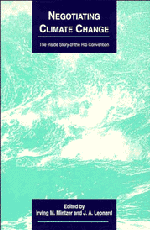Book contents
- Frontmatter
- Contents
- Acknowledgements
- Commonly Used Acronyms
- Foreword
- Part I Background
- Part II Views from Within the Ring
- 3 Exercising Common but Differentiated Responsibility
- 4 The Beginnings of an International Climate Law
- 5 Constructive Damage to the Status Quo
- 6 The Climate Change Negotiations
- 7 A Personal Assessment
- 8 The Road to Rio
- 9 A Failure of Presidential Leadership
- 10 Looking Back to See Forward
- Part III The Outside Edges In
- Part IV Prospects for the Future
- Appendix: The Framework Convention on Climate Change
- Index
4 - The Beginnings of an International Climate Law
Published online by Cambridge University Press: 01 June 2011
- Frontmatter
- Contents
- Acknowledgements
- Commonly Used Acronyms
- Foreword
- Part I Background
- Part II Views from Within the Ring
- 3 Exercising Common but Differentiated Responsibility
- 4 The Beginnings of an International Climate Law
- 5 Constructive Damage to the Status Quo
- 6 The Climate Change Negotiations
- 7 A Personal Assessment
- 8 The Road to Rio
- 9 A Failure of Presidential Leadership
- 10 Looking Back to See Forward
- Part III The Outside Edges In
- Part IV Prospects for the Future
- Appendix: The Framework Convention on Climate Change
- Index
Summary
Prologue
The twenty-fold increase in world industrial activity since the start of this century has had many negative repercussions for the environment. Pollutants emitted from these activities have seriously altered long-standing balances in the chemical composition of the Earth's atmosphere. During the 1980s, the annual increase in world industrial output was approximately equivalent to the total industrial production of Europe during the 1930s. Annual emissions of carbon dioxide in 1992 are estimated to be more than 20 billion tonnes, a figure that is expected to double before the year 2030. The effects of these steadily increasing emissions are reflected in today's elevated atmospheric concentrations of CO2 and other greenhouse gases. The concentrations of several greenhouse gases will remain high for decades. This is particularly true for carbon dioxide, which has a residence time in the atmosphere of up to 200 years.
Moreover, while mankind has succeeded in considerably increasing the sources of greenhouse gas emissions, we have at the same time significantly reduced the natural sinks (i.e., biological reservoirs that store carbon), especially through the processes leading to deforestation and desertification. More than one-third of the earth's original forest cover has already been lost due to the frenzied pace of deforestation. The global rate of forest loss today exceeds 17 million hectares per year. In some regions, twenty-nine trees are cut for each one that is planted.
- Type
- Chapter
- Information
- Negotiating Climate ChangeThe Inside Story of the Rio Convention, pp. 97 - 112Publisher: Cambridge University PressPrint publication year: 1994
- 3
- Cited by



